ICNP-3 Side-event Report on: "Current Japanese Status for Implementation of Nagoya Protocol"
On the occasion of the Third Meeting of the Open-ended Ad Hoc Intergovernmental Committee for the Nagoya Protocol (ICNP-3) which was held in Pyeongchang, Republic of Korea on 24-28 February 2014, Japan Bioindustry Association (JBA) organized a side-event (lunch time seminar) titled “Current Japanese Status for Implementation of Nagoya Protocol” on 24 February, under the support of National Institute of Technology and Evaluation (NITE), and in collaboration with the Ministry of Environment, the Ministry of Economy, Trade and Industry, the Ministry of Foreign Affairs and the Ministry of Education, Culture, Sports, Science and Technology of Japan.
The following five invited speakers made presentations to introduce the current status for implementation of Nagoya Protocol on the access to and benefit-sharing of genetic resources (ABS) from their respective standpoints.
Firstly, Prof. H. Isozaki, chairman of “the Consultative Committee on the Direction of the Domestic Measures Suitable for Japan”, reported on the progress of the discussion and outlined the major issues raised in the Committee’s meetings.
Dr. K. Ando introduced the activities of NITE-BRC (Biological Resources Center of NITE) in collaboration with Asian countries for the networking of culture collections and microbial research in compliance with the CBD.
Dr. Siti Nuramaliati Prijono from LIPI (Indonesian Institute of Science) presented Indonesian experiences in collaborative research between Indonesia and Japan, as examples of activities that have been contributing to the conservation of biological diversity and the capacity building in her country, based on the long term research partnership.
Dr. M. Suzuki introduced the role and activities of ABS team at the National Institute of Genetics in raising awareness and advising universities and public research institutions in Japan in recent years.
Finally, Dr. S. Sumida of JBA introduced “the Second Edition of Guidelines on Access to Genetic Resources for Users in Japan” as a user country measure for the transitional period before the Protocol is implemented in Japan. Its first edition was published in 2005 and revised soon after the Nagoya Protocol was adopted in 2010. The English translation of the Second Edition was finalized in February 2014 and distributed at the ICNP-3 venue.
JBA believes that the seminar was helpful for the participants to understand Japan’s persistent efforts so far to implement ABS in the context of the CBD and Bonn Guidelines, and her recent efforts being strenuously made for the ratification of Nagoya Protocol. Please see below for further details of the presentations.
Lastly, JBA acknowledges all the speakers and the people who worked with us for the big success of this event. We will continue to work hard for ABS implementation.
- "Summary of the discussion in the Consultative Committee on the direction of domestic measures established by MoEJ"

Prof. Hiroji ISOZAKI (Professor of International Environmental Law at the Sophia University)
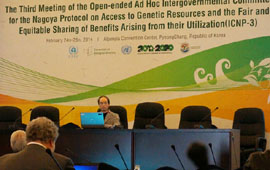 Ministry of the Environment of Japan has organized an advisory group to consider the future domestic measures suitable for Japan in order to prepare for the ratification of the Nagoya Protocol since September 2012 composed of experts including industries and academic fields. A draft report of the group was recently published and called for comments from the public. The final report of the group will be published in March 2014. This presentation overviews the framework of the draft report and explains the major issues and points raised and discussed in the group meetings.
Ministry of the Environment of Japan has organized an advisory group to consider the future domestic measures suitable for Japan in order to prepare for the ratification of the Nagoya Protocol since September 2012 composed of experts including industries and academic fields. A draft report of the group was recently published and called for comments from the public. The final report of the group will be published in March 2014. This presentation overviews the framework of the draft report and explains the major issues and points raised and discussed in the group meetings.
- "International Collaboration in Networking of Culture Collections and Microbial Research"

Dr. Katsuhiko ANDO (Biological Resource Center, National Institute of Technology and Evaluation (NITE), JAPAN)
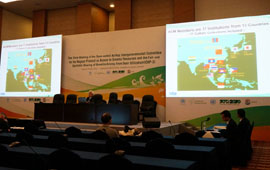 NITE contributed to the establishment of the Asian Consortium for the Conservation and sustainable Use of Microbial Resources (ACM) with 13 Asian countries (India, Indonesia, Cambodia, China, Japan, Korea, Lao, Malaysia, Mongolia, Myanmar, Philippines, Thailand, and Vietnam). The ACM is aimed mainly at the following activities; (1) Human resource development and capacity building, (2) Establishment of a network of biological resource centers and the database, and (3) Development of the material transfer system in compliance with the CBD and the Nagoya Protocol. NITE signed memorandums of understanding with governmental organizations in Asian countries; with Indonesia, Mongolia, Vietnam and Myanmar for the conservation and sustainable use of microbial resources, and with China and Thailand for collaboration between culture collections.
NITE contributed to the establishment of the Asian Consortium for the Conservation and sustainable Use of Microbial Resources (ACM) with 13 Asian countries (India, Indonesia, Cambodia, China, Japan, Korea, Lao, Malaysia, Mongolia, Myanmar, Philippines, Thailand, and Vietnam). The ACM is aimed mainly at the following activities; (1) Human resource development and capacity building, (2) Establishment of a network of biological resource centers and the database, and (3) Development of the material transfer system in compliance with the CBD and the Nagoya Protocol. NITE signed memorandums of understanding with governmental organizations in Asian countries; with Indonesia, Mongolia, Vietnam and Myanmar for the conservation and sustainable use of microbial resources, and with China and Thailand for collaboration between culture collections.
- "Experience in Collaborative Research between Indonesia and Japan"

Dr. Siti Nuramaliati PRIJONO
(Deputy Chairman for Life Science, Indonesian Institute of Science (LIPI))
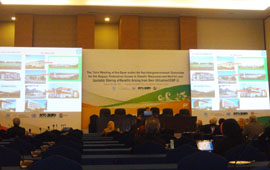 Indonesia’s biodiversity is the country’s greatest natural resources. Efforts to conserve biodiversity in the tropical region and archipelagic areas such as Indonesia are very important since many places are centre of origin, centre of diversity and centre of endemism.
Indonesia’s biodiversity is the country’s greatest natural resources. Efforts to conserve biodiversity in the tropical region and archipelagic areas such as Indonesia are very important since many places are centre of origin, centre of diversity and centre of endemism.
Regarding the Regulations of the Government of the Republic of Indonesia Number 8, 1999, the Indonesian Institute of Sciences (LIPI) is appointed to be a Scientific Authority for the conservation of biodiversity in Indonesia. As a national scientific authority on biodiversity, LIPI play key important role on biodiversity research and strongly contribute on the national biodiversity action plan, and actively promoting global research partnership on biodiversity. Promoting biodiversity research means much more than just setting research agendas. It requires improving skills and institutional capacity. Advancing the research agenda will require intensified cooperation between developed and developing countries.
Indonesia and Japan establish long term research partnership from the 1980-an, as shown by mutual research collaboration between the scientist of both countries. Since 1995 the Government of Japan has implemented a wide range of cooperation projects on biodiversity conservation in Indonesia. The grant aid was provided for the Biodiversity Conservation Project for constructing facilities and procuring equipment at zoological division (1995-1996), and technical cooperation project for Biodiversity Conservation Project Phase I (1995-1998) and Phase II (1998-2003). Furthermore, LIPI get another grant aid project on Improvement of Research Facilities for Biodiversity Conservation and Utilization (2004-2006) to promote research in and education on conservation of plants and microbes. This grant aid project followed by technical cooperation project on Improvement of Collection Management and Biodiversity Research Capacity (2007-2009). All the projects are relevant with the national development plans and the Indonesia Biodiversity Strategy and Action Plan.
The success of those projects facilitated promotion of the new project on Science and Technology Research Partnership for Sustainable Development (SATREPS) 2011-2016 (program launched by JST and JICA). This project focused on “The Development of Internationally Standardized Microbial Collection to Promote Life Science Research and Biotechnology”. The output of this project is microbial collection for facilitating biotechnology research and exploring its potential use for energy, health, agricultural and ecosystem restoration. Again we are very fortunate to get another SATREPS on “Innovative Bio-Production in Indonesia (iBioI): Integrated Bio-Refinary Strategy to Promote Biomass Utilization Using Super-Microbes For Fuel and Chemicals Production” as model extension on how microbial resources can be very valuable for industrial purposes.
It is obvious that the projects are examples for the implementation of Nagoya Protocol. The collaborative research between Indonesia and Japan through several projects on Biodiversity demonstrates not only promotes and safeguards the fair and equitable sharing of benefits arising from the utilization of genetic resources, it also significantly contributing to the national capacity building of the provider in both management and scientific skill and improve public awareness.
- "Introduction of ABS Task Force Team for Academia"

Dr. Mutsuaki SUZUKI (Intellectual Property Unit, National Institute of Genetics in Japan)
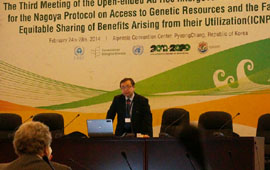 The ABS Task Force Team for Academia at the National Institute of Genetics in Japan takes on an important role of raising awareness, advising universities and public research institutions, and collecting opinions on the handling of genetic resources as it relates to complying with the Nagoya Protocol in academic fields. We have already held more than 40 seminars and symposiums on ABS at universities around Japan in the past two years. We have also developed and distribute communication materials related to ABS. In this side event, we introduce our recent activities.
The ABS Task Force Team for Academia at the National Institute of Genetics in Japan takes on an important role of raising awareness, advising universities and public research institutions, and collecting opinions on the handling of genetic resources as it relates to complying with the Nagoya Protocol in academic fields. We have already held more than 40 seminars and symposiums on ABS at universities around Japan in the past two years. We have also developed and distribute communication materials related to ABS. In this side event, we introduce our recent activities.
- "Guidelines on Access to Genetic Resources for Users in Japan, Second Edition, 2012" - User Country Measure in Transitional Period –

Dr. Seizo SUMIDA (Japan Bioindustry Association)
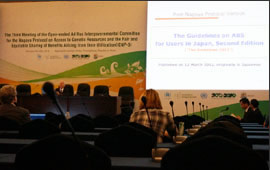 The Ministry of Economy, Trade and Industry and Japan Bioindustry Association together developed the first edition of the Guidelines in 2005 as a user country measure. After the adoption of Nagoya Protocol in 2010, we revised the Guidelines to incorporate principles of NP in 2012 (The Guidelines 2012). Its English translation is now launched. The values of The Guidelines 2012 during the transitional period leading to implementation of NP will be discussed.
The Ministry of Economy, Trade and Industry and Japan Bioindustry Association together developed the first edition of the Guidelines in 2005 as a user country measure. After the adoption of Nagoya Protocol in 2010, we revised the Guidelines to incorporate principles of NP in 2012 (The Guidelines 2012). Its English translation is now launched. The values of The Guidelines 2012 during the transitional period leading to implementation of NP will be discussed.
The following five invited speakers made presentations to introduce the current status for implementation of Nagoya Protocol on the access to and benefit-sharing of genetic resources (ABS) from their respective standpoints.
Firstly, Prof. H. Isozaki, chairman of “the Consultative Committee on the Direction of the Domestic Measures Suitable for Japan”, reported on the progress of the discussion and outlined the major issues raised in the Committee’s meetings.
Dr. K. Ando introduced the activities of NITE-BRC (Biological Resources Center of NITE) in collaboration with Asian countries for the networking of culture collections and microbial research in compliance with the CBD.
Dr. Siti Nuramaliati Prijono from LIPI (Indonesian Institute of Science) presented Indonesian experiences in collaborative research between Indonesia and Japan, as examples of activities that have been contributing to the conservation of biological diversity and the capacity building in her country, based on the long term research partnership.
Dr. M. Suzuki introduced the role and activities of ABS team at the National Institute of Genetics in raising awareness and advising universities and public research institutions in Japan in recent years.
Finally, Dr. S. Sumida of JBA introduced “the Second Edition of Guidelines on Access to Genetic Resources for Users in Japan” as a user country measure for the transitional period before the Protocol is implemented in Japan. Its first edition was published in 2005 and revised soon after the Nagoya Protocol was adopted in 2010. The English translation of the Second Edition was finalized in February 2014 and distributed at the ICNP-3 venue.
JBA believes that the seminar was helpful for the participants to understand Japan’s persistent efforts so far to implement ABS in the context of the CBD and Bonn Guidelines, and her recent efforts being strenuously made for the ratification of Nagoya Protocol. Please see below for further details of the presentations.
Lastly, JBA acknowledges all the speakers and the people who worked with us for the big success of this event. We will continue to work hard for ABS implementation.
Prof. Hiroji ISOZAKI (Professor of International Environmental Law at the Sophia University)
 Ministry of the Environment of Japan has organized an advisory group to consider the future domestic measures suitable for Japan in order to prepare for the ratification of the Nagoya Protocol since September 2012 composed of experts including industries and academic fields. A draft report of the group was recently published and called for comments from the public. The final report of the group will be published in March 2014. This presentation overviews the framework of the draft report and explains the major issues and points raised and discussed in the group meetings.
Ministry of the Environment of Japan has organized an advisory group to consider the future domestic measures suitable for Japan in order to prepare for the ratification of the Nagoya Protocol since September 2012 composed of experts including industries and academic fields. A draft report of the group was recently published and called for comments from the public. The final report of the group will be published in March 2014. This presentation overviews the framework of the draft report and explains the major issues and points raised and discussed in the group meetings.
Dr. Katsuhiko ANDO (Biological Resource Center, National Institute of Technology and Evaluation (NITE), JAPAN)
 NITE contributed to the establishment of the Asian Consortium for the Conservation and sustainable Use of Microbial Resources (ACM) with 13 Asian countries (India, Indonesia, Cambodia, China, Japan, Korea, Lao, Malaysia, Mongolia, Myanmar, Philippines, Thailand, and Vietnam). The ACM is aimed mainly at the following activities; (1) Human resource development and capacity building, (2) Establishment of a network of biological resource centers and the database, and (3) Development of the material transfer system in compliance with the CBD and the Nagoya Protocol. NITE signed memorandums of understanding with governmental organizations in Asian countries; with Indonesia, Mongolia, Vietnam and Myanmar for the conservation and sustainable use of microbial resources, and with China and Thailand for collaboration between culture collections.
NITE contributed to the establishment of the Asian Consortium for the Conservation and sustainable Use of Microbial Resources (ACM) with 13 Asian countries (India, Indonesia, Cambodia, China, Japan, Korea, Lao, Malaysia, Mongolia, Myanmar, Philippines, Thailand, and Vietnam). The ACM is aimed mainly at the following activities; (1) Human resource development and capacity building, (2) Establishment of a network of biological resource centers and the database, and (3) Development of the material transfer system in compliance with the CBD and the Nagoya Protocol. NITE signed memorandums of understanding with governmental organizations in Asian countries; with Indonesia, Mongolia, Vietnam and Myanmar for the conservation and sustainable use of microbial resources, and with China and Thailand for collaboration between culture collections.
Dr. Siti Nuramaliati PRIJONO
(Deputy Chairman for Life Science, Indonesian Institute of Science (LIPI))
 Indonesia’s biodiversity is the country’s greatest natural resources. Efforts to conserve biodiversity in the tropical region and archipelagic areas such as Indonesia are very important since many places are centre of origin, centre of diversity and centre of endemism.
Indonesia’s biodiversity is the country’s greatest natural resources. Efforts to conserve biodiversity in the tropical region and archipelagic areas such as Indonesia are very important since many places are centre of origin, centre of diversity and centre of endemism. Regarding the Regulations of the Government of the Republic of Indonesia Number 8, 1999, the Indonesian Institute of Sciences (LIPI) is appointed to be a Scientific Authority for the conservation of biodiversity in Indonesia. As a national scientific authority on biodiversity, LIPI play key important role on biodiversity research and strongly contribute on the national biodiversity action plan, and actively promoting global research partnership on biodiversity. Promoting biodiversity research means much more than just setting research agendas. It requires improving skills and institutional capacity. Advancing the research agenda will require intensified cooperation between developed and developing countries.
Indonesia and Japan establish long term research partnership from the 1980-an, as shown by mutual research collaboration between the scientist of both countries. Since 1995 the Government of Japan has implemented a wide range of cooperation projects on biodiversity conservation in Indonesia. The grant aid was provided for the Biodiversity Conservation Project for constructing facilities and procuring equipment at zoological division (1995-1996), and technical cooperation project for Biodiversity Conservation Project Phase I (1995-1998) and Phase II (1998-2003). Furthermore, LIPI get another grant aid project on Improvement of Research Facilities for Biodiversity Conservation and Utilization (2004-2006) to promote research in and education on conservation of plants and microbes. This grant aid project followed by technical cooperation project on Improvement of Collection Management and Biodiversity Research Capacity (2007-2009). All the projects are relevant with the national development plans and the Indonesia Biodiversity Strategy and Action Plan.
The success of those projects facilitated promotion of the new project on Science and Technology Research Partnership for Sustainable Development (SATREPS) 2011-2016 (program launched by JST and JICA). This project focused on “The Development of Internationally Standardized Microbial Collection to Promote Life Science Research and Biotechnology”. The output of this project is microbial collection for facilitating biotechnology research and exploring its potential use for energy, health, agricultural and ecosystem restoration. Again we are very fortunate to get another SATREPS on “Innovative Bio-Production in Indonesia (iBioI): Integrated Bio-Refinary Strategy to Promote Biomass Utilization Using Super-Microbes For Fuel and Chemicals Production” as model extension on how microbial resources can be very valuable for industrial purposes.
It is obvious that the projects are examples for the implementation of Nagoya Protocol. The collaborative research between Indonesia and Japan through several projects on Biodiversity demonstrates not only promotes and safeguards the fair and equitable sharing of benefits arising from the utilization of genetic resources, it also significantly contributing to the national capacity building of the provider in both management and scientific skill and improve public awareness.
Dr. Mutsuaki SUZUKI (Intellectual Property Unit, National Institute of Genetics in Japan)
 The ABS Task Force Team for Academia at the National Institute of Genetics in Japan takes on an important role of raising awareness, advising universities and public research institutions, and collecting opinions on the handling of genetic resources as it relates to complying with the Nagoya Protocol in academic fields. We have already held more than 40 seminars and symposiums on ABS at universities around Japan in the past two years. We have also developed and distribute communication materials related to ABS. In this side event, we introduce our recent activities.
The ABS Task Force Team for Academia at the National Institute of Genetics in Japan takes on an important role of raising awareness, advising universities and public research institutions, and collecting opinions on the handling of genetic resources as it relates to complying with the Nagoya Protocol in academic fields. We have already held more than 40 seminars and symposiums on ABS at universities around Japan in the past two years. We have also developed and distribute communication materials related to ABS. In this side event, we introduce our recent activities.
Dr. Seizo SUMIDA (Japan Bioindustry Association)
 The Ministry of Economy, Trade and Industry and Japan Bioindustry Association together developed the first edition of the Guidelines in 2005 as a user country measure. After the adoption of Nagoya Protocol in 2010, we revised the Guidelines to incorporate principles of NP in 2012 (The Guidelines 2012). Its English translation is now launched. The values of The Guidelines 2012 during the transitional period leading to implementation of NP will be discussed.
The Ministry of Economy, Trade and Industry and Japan Bioindustry Association together developed the first edition of the Guidelines in 2005 as a user country measure. After the adoption of Nagoya Protocol in 2010, we revised the Guidelines to incorporate principles of NP in 2012 (The Guidelines 2012). Its English translation is now launched. The values of The Guidelines 2012 during the transitional period leading to implementation of NP will be discussed.
